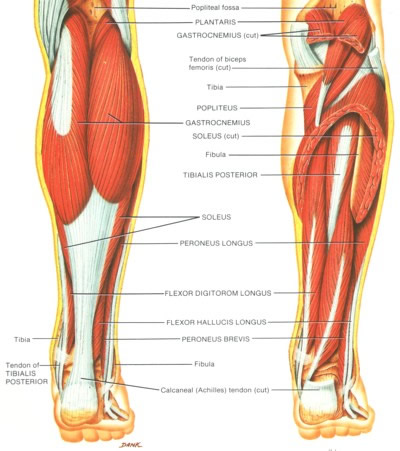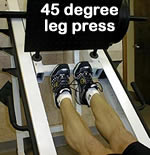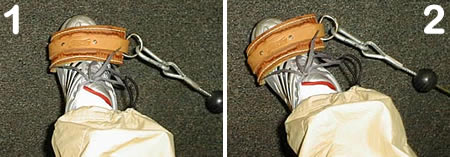 Calves are a weak spot for most weightlifters and athletes. Your average male weightlifter doesn’t put the same effort into his legs as he does into his chest and biceps. Well I am here to tell you that it’s actually easy to develop some meaty ass calves as long as you’re doing your foundation exercises.
Calves are a weak spot for most weightlifters and athletes. Your average male weightlifter doesn’t put the same effort into his legs as he does into his chest and biceps. Well I am here to tell you that it’s actually easy to develop some meaty ass calves as long as you’re doing your foundation exercises.
Calf Physiology
Bones and Joints
The lower leg is comprised of two long bones, the tibia and fibula. The tibia is the larger of the two and is located toward the middle of the lower leg. The fibula is the smaller bone and it is located on the outside of the lower leg.
Muscles

There are many muscles the lower leg, but the four major muscles you may have heard of are the gastrocnemius, which comprises the two slabs of steak on the back of your calf; the soleus which runs underneath the steaks; the anterior tibialis, which is on the front lower leg; and the achilles tendon is located in the lower leg between the heal and the soleus/gastroc area.
But perhaps you want more details. The lower leg is divided into the following four sections of muscles:
Anterior
The front of the shin holds the tibialis anterior, the extensor digitorum longus, the extensor hallucus longus and the peroneus tertius muscles. These muscles pull the foot and toes upward (dorsiflexion). The tibialis anterior assists with turning the foot inward. To feel these muscles contract, place your hand just to the outside of the tibia and pull the foot up.
Lateral
Along the outside of the lower leg runs the peroneus longus and peroneus brevis muscles. These muscles pull the foot outward. These muscles helps point the foot (plantarflexion). To feel these muscles contract, place your hand on the outside of your shin and turn your foot out.
Posterior
The top portion of the back of your lower leg holds the large muscles that are most commonly known as the calf muscles. These are the gastrocnemius and soleus, and also the plantaris. The gastrocnemius is shorter, thicker and has innner and outer attachments. It is the most visible of the calf muscles. The soleus lies underneath. These three muscles attach to the achilles tendon. They all aid with plantarflexion.
Deep Posterior
Deep within the back of the lower leg lies the tibialis posterior, flexor digitorum longus, and flexor hallucus longus. Tibialis posterior pulls the foot inward, flexor digitorum longus flexes the toes, and flexor hallucus longus flexes the big toe. All three aide in plantarflexion.
How to Train the Calves for Maximal Growth
Your calves are capable of a very high volume of work. This is because you walk, jump, and step up with them all day long. This is also why I say it is “easy” to build meaty calves; they recover completely from moderate trauma within just a day or two, unlike some of the bigger muscles in your legs, chest, and back.
In effect, we are able to train the calves with very heavy loads almost everyday. Especially if we attack the muscles from different angles and leverage points in each workout.
Training the Legs
Just because we are focusing on calves, doesn’t mean we can neglect our quads and hamstrings. In fact, just the opposite. Squats and deadlifts provide the foundation of core strength in your whole body, including your calves. This makes those two exercises mandatory for meaty calves. One exercise specifically, the JUMP SQUAT, is key to calf growth because it combines the stability of a squat with the ankle flexion of a calf raise.
Training the Gastroc
Any straight leg ankle flexion and extension will train the gastrocs. You can use the following exercises:
- Weighted standing calf raises, usually on a machine.
- Weighted standing one-leg calf raises, usually on a machine or holding a dumbbell.
- Donkey calf raises, usually with someone sitting on your back, or on a machine, or with weight hanging from a belt on your hips. Use either one or two legs with the hanging weight method.
- Jump squats.
- 45 degree leg press, one or two legs. Put only your toes on the platform, with heels hanging below, keep your legs straight.

Training the Soleus
Any bent leg ankle flexion or extension will train the soleus. You can use the following exercises:
- Seated calf raises, usually on a machine.
- Seated one leg calf raises, on a machine or with weight on top of the knee.
Training Everything Else
To train the various smaller muscles, we will need either light weight plates or a cable attachment that can be secured around the foot. Use the following exercises to train the smaller muscles in your calves:
- Start by lying down and securing a cable to your foot, keep your heel against an immovable object throughout the set, your ankle should be extended (point your toes away from you, or down) to start the rep. Now flex your ankle (point your toes towards your face, or up) to contract the tibilais anterior. Extend your ankle again to finish the rep.
This could also be done standing with a cable or standing with a weight plate on the front of your toes, but the way I described it above works best.
- Toss a plate on the floor and put your foot right beside it. Keeping your heel in one spot, use your toes to push the plate away from your body, pivoting on the heel, to contract the peroneus muscles.
This could also be done with a cable.
- Toss a plate on the floor and put your foot right beside it. Keeping your heel in one spot, use your toes to push the plate towards your body, pivoting on the heel, to contract the tibialis posterior.
This could also be done with a cable.

- If you really want to get nitty gritty and build massive toe muscles, you could stick your foot in a bucket of sand or rice and repeatedly flex and relax all your toes. People do this for hand, finger, and grip strength, so I assume it could be applied to the toes. Of course, I have never done this and I would probably feel pretty silly if I tried it. Up to you.
The Calves to Cows Workout Plan
You will be supersetting calf exercises with upper body exercises in order get in the required volume. This is the best way to develop massive calves while not letting any other muscle groups suffer. Be sure not to superset calves with squats or any other leg exercise as it will only hinder your legs.
The exercises specified by a) should be done first in the superset and the exercises specified by b) should be done second. You should not be resting much between exercises in a superset, but definitely rest for 60-90 seconds after each superset.
Drink plenty of your sports drink of choice during the workout. I recommend Gatorade or Biotest Surge.
Stick to this program for 2 months to see maximum benefits. After that point it will be time to give the calves a rest for a while, but you can still maintain one calf exercise per workout for the rest of your life.
Oh, and do yourself a favor: STRETCH YOUR CALVES EVERY SINGLE DAY, and especially after these workouts.
Day 1:
1a) Flat chest (warm up, then 3 sets x 5 reps)
1b) Standing calf raises (warm up, then 3 sets x 10 reps)
2a) Deadlifts (warm up, then 3 sets x 5 reps)
2b) Abs (warm up, then 3 sets x 10 reps)
3a) Shoulder press (3 sets x 5 reps)
3b) Seated one leg calf raises (3 sets x 5 reps)
4a) Vertical back (pull downs or pull ups [weighted if possible]) (3 sets x 7 reps)
4b) Peroneus flexion (pointing the toes away) (3 sets x 10 reps)
Day 2:
Off or light exercise.
Day 3:
1a) Squats (warm up, then 3 sets x 5 reps)
1b) Abs (warm up, then 3 sets x 5 reps)
2a) Horizontal back (cable, barbell, or dumbbell rows) (3 sets x 5 reps)
2b) Seated calf raises (warm up, then 3 sets x 10 reps)
3a) Incline chest (then 3 sets x 5 reps)
3b) Standing one leg calf raises (3 sets x 5 reps)
4a) Traps (barbell or dumbbell shrugs) (3 sets x 5 reps)
4b) Tibialis anterior flexion (raising the toes) (3 sets x 10 reps)
Day 4:
Off or light exercise.
Day 5:
1a) Shoulder press (warm up, then 3 sets x 5 reps)
1b) Standing donkey calf raise, either with someone on your back and you stand on two legs, or with a weight hanging from your hips and you stand on either one or two legs. (2 sets x 20 reps only)
2a) Jump squats using 30% of your max squat (3 sets x 10 reps)
2b) Vertical back (chin ups, weighted if possible, assisted if necessary) (3 sets x 7 reps)
3a) Plyometric push ups (clapping, jump onto plates, one-arm switching sides, be creative) (3 sets x failure)
3b) Seated calf raises (2 sets x 20 reps)
4a) Squats standing on your toes (weighted by holding dumbbells if possible) (3 sets x 2 minutes)
4b) Tibialis posterior flexion (pointing the toes in) (3 sets x 10 reps)
Day 6:
Completely off, no exercise at all.
Day 7:
Off or start over at day 1.
Nutrition
Focusing on your calves does not require anything special nutrition wise. You should be eating your regular moderate protein diet (How much protein should I eat in a day?), drinking plenty of water, and whether you are dieting or not, you should see a huge change in your calves after 2 months. Consume carbs before during and after your workout, mostly in liquid form. See my variety of other diet articles if you need to know more about nutrition.
Tags: calf training, calves, routines, training











Jump Squats and Plyometrics are great for some nice looking calves 🙂
Steve,
As a young man I worked out religiously and built a pretty stout physic. I am now 47 and have leaned down as my work schedule became more hectic and my fitness time more restricted. That has worked out just fine with the exception of my calves. I’m 5’8″ and my calves measure 18″ in circumference, talk about cows… I frequently run for very long periods of time. I’ve tried high reps w/ low weight and that seems to only add definition. What can I do to reduce their circumference?
How can I incorporate this with the werewolf training?
You could superset all of the calf exercises with other exercises that are not already in a superset.
Hey, Steve!
Great article. To be as terse as possible:
“•Toss a plate on the floor and put your foot right beside it. Keeping your heel in one spot, use your toes to push the plate away from your body, pivoting on the heel, to contract the peroneus muscles.
This could also be done with a cable.
•Toss a plate on the floor and put your foot right beside it. Keeping your heel in one spot, use your toes to push the plate towards your body, pivoting on the heel, to contract the tibialis posterior.”
Could you rephrase this exercise please? I have to be doing it wrong. What I do is I put a plate(for a barbell) on the floor to either side of my foot. Then, I push or pull the plate towards or away from me. That, to my understanding, is a rep. How do I start the next rep?
Once again, great article, thanks for posting it!
To start the next rep, just reposition your foot.
hello, i do the jump manuel which consists of weightlifting and plyometric exercises. After I do them both withing a week my legs feel refreshed and i tend to jump higher then normal. however couple days later my left calfs around the soelus muscle aches and i feel tension when i try to jump. what do you think is wrong with my calfs.
New to workout plans but can you please help me here Steve.
I was wondering if there was a way to incorporate a bicep workout into this, or am I relying on back exercises for that? Also, should I repeat supersets? IE do the flat chest and standing calf raises twice each (with a 60 to 90 second rest in between each superset)?
I also have a problem like fran’s but throughout the entire game. The problem is i know i have quite meaty calves, I put a lot of exercise into them, I run a lot in school p.e lessons doing high intensity work. Ive played football all my life and have had the problem for about 2-3 years. My calves really ache whenever i run for prolonged periods of time. I dont know why this is whether i run inefficiently, Due to flexibility or just a heavy load on gastrocs and soleus because i would class myself as a bodybuilder rather than an athletic football player. Im 5’3 Ft, 8.9 stone with a body fat percentage of 12. Just to show you im not fat in any way i have a 6 pack and im very muscular. If youve come across this problem before please reply, thanks.
Toby: Maybe you do too much calf work and they are overtrained? Hopefully it is not a problem with your Achilles tendon. Just be careful. Check with your doc if you want to know more.
Hey steve, always a pleasure reading your posts. I play soccer, and im actually doing the p90x routine for conditioning. The thing is, altough i feel way much better in terms of strenght, speed and aerobic capacity, i keep suffering from cramps in my calves during the last minutes of the matches. I hydrate before the match, eat bananas quite often, but i stiil get them. Do you think a reason could be an under development of the calves?? p90x focuses on some calves excersises, but maybe they are not enough… anyway, maybe when you were a trainer you ve dealt with issues like mine…. thanks a lot for you concern steve. cheers
Foam rolling the calves several times a week may help to lessen the cramping over time (helps to break down scar tissue, muscle adhesions, etc.).
Is this actually true, or is this a bunch of bull-shit?
It’s true alright Oskie. Try the workout for 3 months and see what happens to your calves in the meantime.